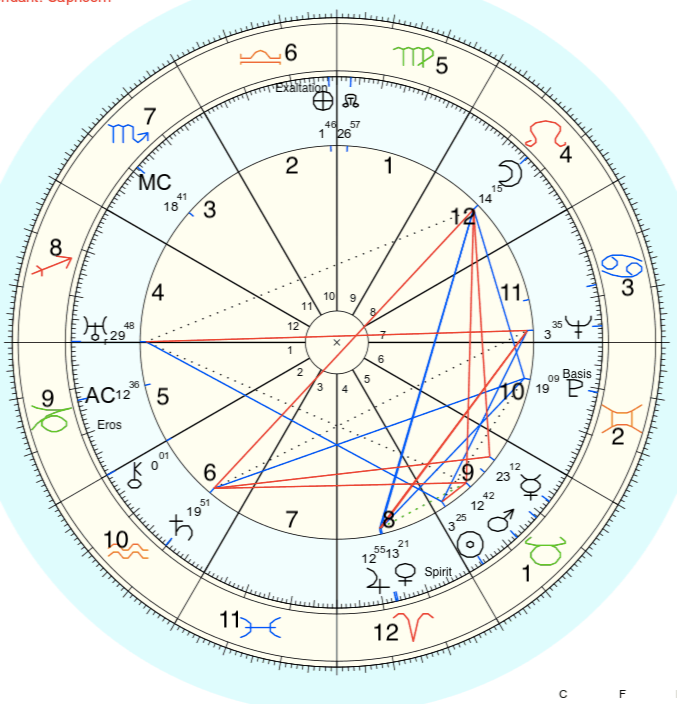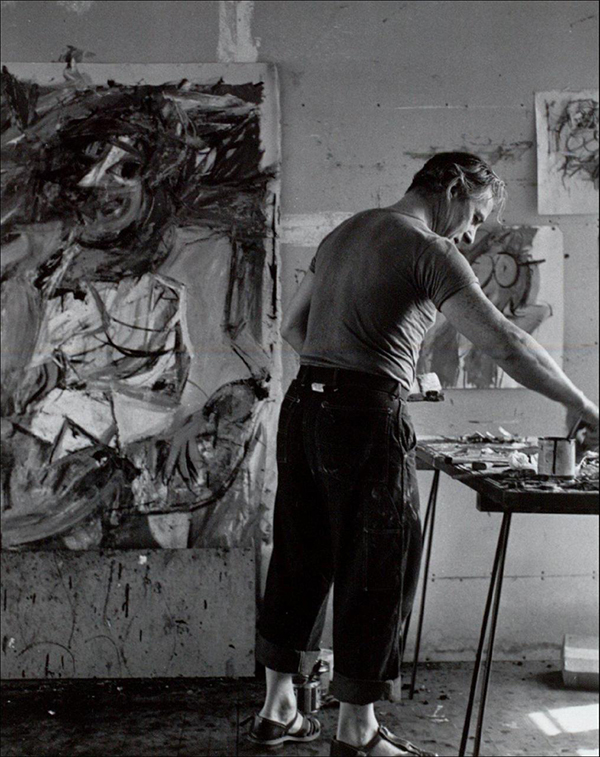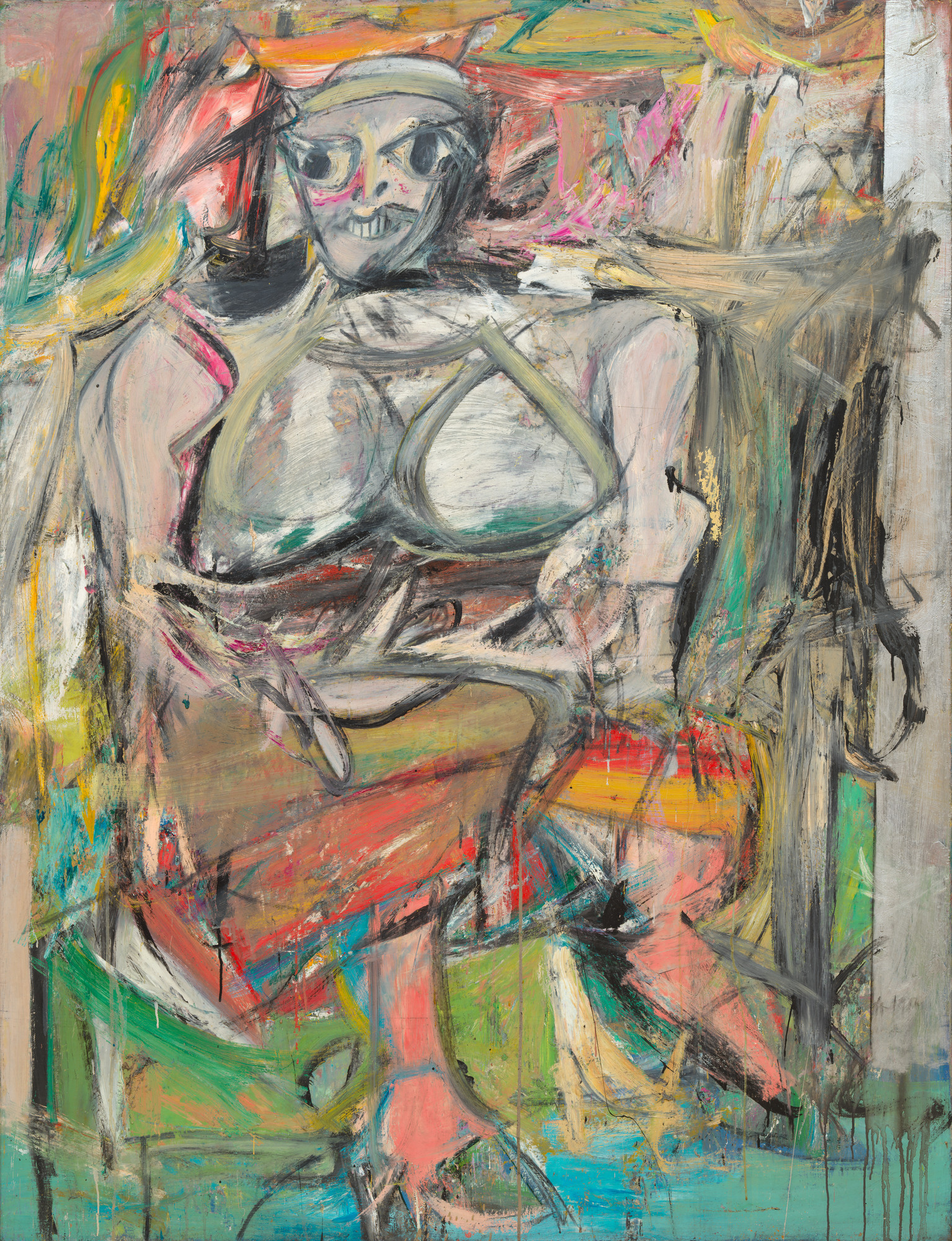If you were to conjure an image of the abstract expressionist scene in 1940s New York City, you’d immediately think of painters congregating in the (now condo-ized) Cedar Bar, drinking in close quarters in dim smoky light.
Willem de Kooning, a Dutch immigrant, would number among the crowd, a fixture in the downtown art scene. He was mostly known and revered by other artists, relatively underground until his first real show at the Charles Egan Gallery in 1948.
Be that as it may, as art historian Karen Kedmey says, “If Jackson Pollock was the public face of the New York avant-garde, Willem de Kooning could be described as an artist’s artist, who was perceived by many of his peers as its leader.”
Willem arrived in the United States in 1926 as a stowaway on a ship, and after years of making a living as a housepainter, as well as working as an artist in the WPA, he eventually began painting full time in 1935. Armed with a rigorous arts education earned as a young man in Rotterdam, de Kooning stood out amongst his peers for his cool intellectualism, and his ability to conceptualize forms in space, rendering field and subject as enmeshed surface, dripping with lush color.
de Kooning’s Astrology
Born on April 24th, 1904 at 12:40am in Rotterdam, Netherlands, Willem de Kooning is a solar Taurus with a Leo Moon and Capricorn on his ascendant. To engage his natal chart is to engage the chart of someone who blended intellect with creative passion. With Mercury in Taurus as the planet that ruled his North Node—his soul’s mission in this lifetime, we see reflected in this chart the life of one destined to blend art, intellect, and sensuality.
In order to understand de Kooning’s career as an artist, I will be using a technique in which the chart is viewed through the lens of the Nodal axis. I will also use the whole sign house system, and the Hellenistic technique called zodiacal releasing. All of these techniques are specifically tailored to uncover a person’s relation to the world, and discern what they will be doing in relation to that world.

Portrait of a Painter

The point of entry into the natal chart is the ascendant, the angle demarcated by time of the first breath we take in this lifetime. At de Kooning’s birth, the constellation Capricorn, the Saturn-ruled sea-goat, hovered over the horizon. Thus his persona was imprinted with the energy of this sign.
Capricorn rising individuals are known for their serious, hardworking nature, and their innate ability to take charge of situations large and small. With his Capricorn rising, de Kooning’s chart ruler is Saturn, which sits in the sign Aquarius in House 2, the house of values, money, and possessions. When Saturn is in the house of material things, we can find that the native may take a long time to find their financial footing. And indeed, de Kooning was born into a poor family, and was poor through most of his adult life.
His Saturn sits in opposition to his Moon in Leo in House 8, the house of trauma and transformation, which indicates an immense amount of pressure placed on his emotions, likely from structural forces outside of himself. We can relate the opposition of Saturn (which we associate with patriarchy, order, and control) and the Moon (which we associate with feminine energy) intuitively to his controversial Woman series, criticized by many for its disruptive depiction of the female form. Like Saturn bearing down on a woman who is simply being, perhaps something in de Kooning’s psyche was oriented toward the Saturnine dissembling of feminine form.

25 5/8 × 31 7/8 in (65.1 × 81 cm)
The painter’s natal Sun sits in the sign Taurus in House 5, the house of creative fertility, expression, and drama. The Sun is the luminary that represents ego, will, and identity. Taurus is the sign that governs the senses and our values. Ruled by Venus, this fixed earth sign delights in color, texture, consumption of all kinds, and strives to experience the world through the senses—a lovely placement for a painter.
With his Sun conjunct Mars, planet of passion and conquest, also in Taurus, de Kooning’s ego receives a passionate burst of Martian focus geared toward the arts. Perhaps this granted the energy needed to push the painter through difficult material circumstances.
With his Moon in Leo, we find that de Kooning needed to find an artistic sense of self, in order to feel safe. The Moon is the luminary of emotional experience. It describes our needs as children, and how we want to be cared for. Moon in Leo is a luminous placement; pride, passion, creativity, and loyalty are all filtered through the delicate Moon.
With his Moon in House 8, the house of trauma and transformation, we can surmise that his emotional life was afflicted, if not completely alien to him, or otherwise difficult. An eighth house Moon can indicate that emotional experiences are turbulent, and leave a lasting impression on the psyche.
De Kooning was of course known for his action painting, a style through which the artist processes his exact experience, his self-directed drama and unconscious sensations. The tangled shadow of the 8th House can be seen in his explosive abstract painting.
Another possible expression of this Saturnian, limiting, influence on his emotions may be his reputation for perfectionism, which often translated into a critique that he was simply “a genius who can never complete a picture,” due to Saturn’s restrictive impact on his tender Moon. He was known for destroying many of his canvases in the process of working on them, overworking the compositions to the point of no return. This is a characterizing feature of his lore, as well as his painterly style, and I believe is an expression of the cruel perfectionism of Saturn in opposition to his sensitive 8th House Moon.

Karmic Traces
Though each natal chart contains information about the mundane, lived experience, it also contains energetic insight as to the soul’s purpose in this lifetime. The North Node and South Node of the Moon are theoretical points in the cosmos, determined by the place where the Moon crosses the ecliptic. These points describe accumulated past life energy that must be brought into balance (South Node), and a hint at the soul’s mission here on earth (North Node).
De Kooning’s North Node is in Virgo, the sign that gathers in resources, in House 9, the house of foreign culture, aesthetics, and philosophy. This mutable earth sign is ruled by Mercury, thus de Kooning’s North Node ruler is Mercury as well. We find Mercury in the painter’s 5th House, along with the Sun and Mars, in the sign Taurus.
Herein lies the description of what he is meant to do with his life: gather an understanding of the resources (Virgo) of art theory and culture (House 9), and put it to use in the realm of creative expression (Mercury in Taurus, House 5).
As a young man attending the Rotterdam Academy of Fine Arts and Techniques, de Kooning was exposed to all manners of art and craft, learning everything from drawing to pigment grinding, wood-graining and marbleizing. He attended lectures on all aspects of art theory and history, from the Egyptians through the Renaissance. This training is undoubtedly the stuff of the 9th House, and gave him the institutional grounding we associate with House 9 to have enough insight and knowledge (a Virgoan requirement) to make his art.

Nodal Realignment
If we were to shift the chart like a dial, and place the North Node in House 1, we would be performing a kind of nodal reorientation, filtering the mission of the soul’s purpose through the first house of selfhood and identity. This is a theoretical astrological gesture, which seeks to figure what the life looks like when we’re truly engaging that nodal pathway, that spiritual mission.
Performing this operation on de Kooning’s chart reveals that the 9th House becomes the 1st House, which means that in order for him to actualize that North Node mission, he must have a 9th House underpinning, which we established he received as an art student in the Netherlands. (You’ll notice in the chart provided below that there is a third, outermost ring, and this denotes the position of a sign in relation to de Kooning’s North Node ruler, Mercury.) We must now look to the painter’s lots, which are theoretical points derived from various formulae arrived at by Hellenistic astrologers in antiquity. The crucial points are called Fortune, Spirit, Exaltation, and Basis. Importantly, his lot of Exaltation and Fortune are quite close to one another, in the same sign, Libra. The ruler therefore is Venus, which we find in Aries in de Kooning’s 4th House (or the 8th House in his Nodal chart).
The lot of Spirit is in Aries in House 4, the ruler of which is Mars in House 5, bringing our attention back to that activated, artistic 5th House. His lot of Basis is in Gemini in House 6, making the ruler Mercury in Taurus in House 5, further reinforcing his North Node ruler, Mercury, as a powerful planet in the chart. In order to understand how these lots figured in his life (through time), let’s flash forward to his first show at the Charles Egan Gallery in 1948. Using a Hellenistic technique called Zodiacal Releasing, whereby signs in the chart are activated for specific lengths of time, we see, in 1948, that the signs Cancer and Capricorn were activated by Spirit and Fortune. We call this “releasing from Spirit and Fortune.”
Now, releasing from Spirit, specifically, we see Cancer being activated in September 1946. For de Kooning, Cancer resides in the 7th Place of the world, an angle and thus a propitious place to have activated. Its ruler is the Moon, in a period lasting nearly 25 years. Releasing from Fortune now, Capricorn, the 1st Place of the world, is activated (in 1938), which constitutes a nearly 27-year period. Having one’s 1st Place activated is very desirable in and of itself, and we can appreciate the fact that the 7th Place is opposite the 1st, just as de Kooning’s natal lots perceptually activate his 4th and 10th.
This is not only a technical peak period (a time when career ambition is intensified), but all of the angles of de Kooning’s chart are activated by a combination of the natal positions and their activated positions. (De Kooning’s releasing here resembles that of George W. Bush when he became President, in that the four angles are simultaneously activated.) The rulers of de Kooning’s activated lots are the Moon and Saturn, which oppose each other in the chart, as we have already seen.
The Moon itself is angular to Mercury, de Kooning’s North Node ruler—and so is Saturn, which is 10 places from Mercury, indicating its crucial role as a major indicator of career ambition. Aside from this propitious combination of factors, let us recall the meaning of de Kooning’s Saturn opposing his Moon and how this symbolically played out in his iconic Woman series.
It is noteworthy that de Kooning found fame, at last, at this time, when all of his four angle’s rulers were simultaneously activated, enabling the artist to fulfill his nodal mission, which is best summed up by his Mercury in Taurus, in the 5th House of the world and 9th House from his North Node.
De Kooning left a legacy of abstract painterly wonder, achieved through obstinate perfectionism, a distrust of systems, of movements, and conclusions. Slow but relentless—the markings of a true solar Taurus—he conceived a body of work that undoubtedly influenced generations after him, and well into the future of painting. I’ll leave us with some of his words on the matter:
The argument often used that science is really abstract, and that painting could be like music and, for this reason, that you cannot paint a man leaning against a lamp-post is utterly ridiculous. That space of science… I am truly bored with by now. Their lenses are so thick that seen through them, space gets more and more melancholy….The stars I think about, if I could fly, I could reach in a few old-fashioned days. But physicists stars I use as buttons, buttoning up curtains of emptiness. If I stretch my arms next to the rest of myself and wonder where my fingers are—that is all the space I need as a painter.
Cristina Farella is a consulting astrologer and writer located in Eugene, OR. She is the astrologer for the upcoming Celestial Bodies Oracle, which is currently available for pre-order.
Learn more about Cristina and book a session to dive into your own natal chart with her on her website.
Follow Cristina on social media:
Instagram @eighthhouseastro
Twitter @CristinaFarella



